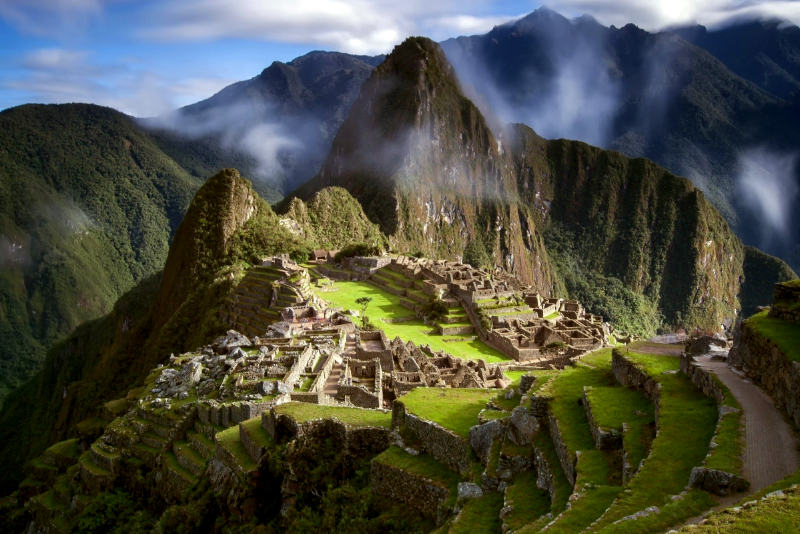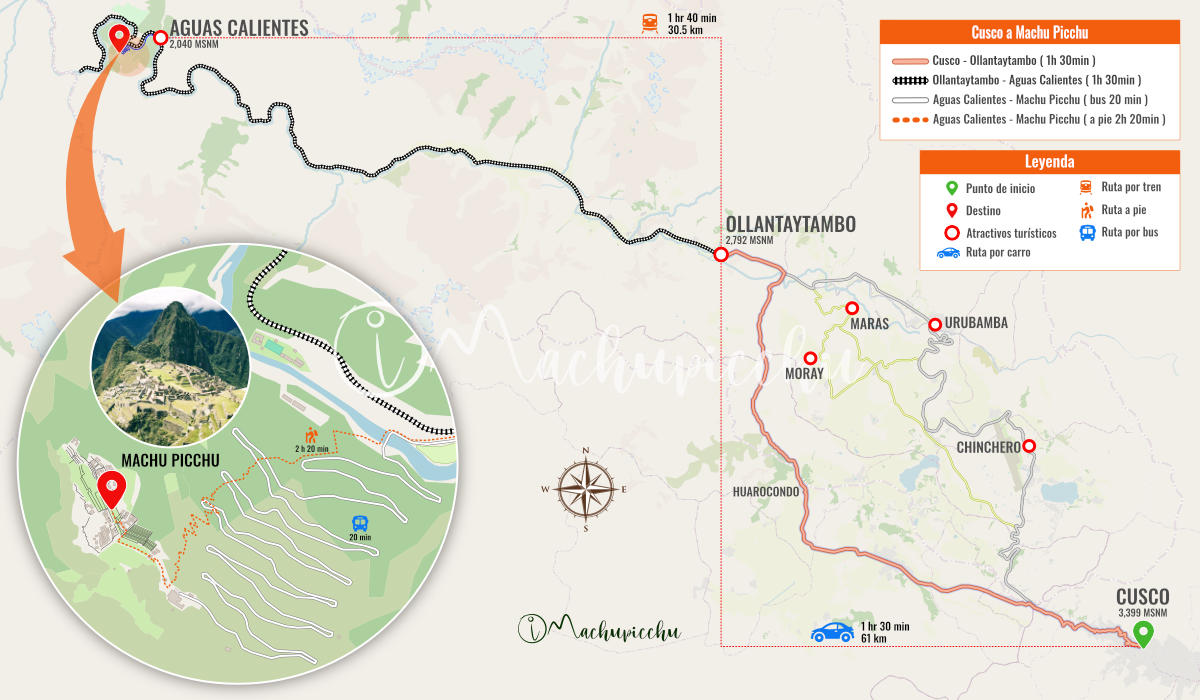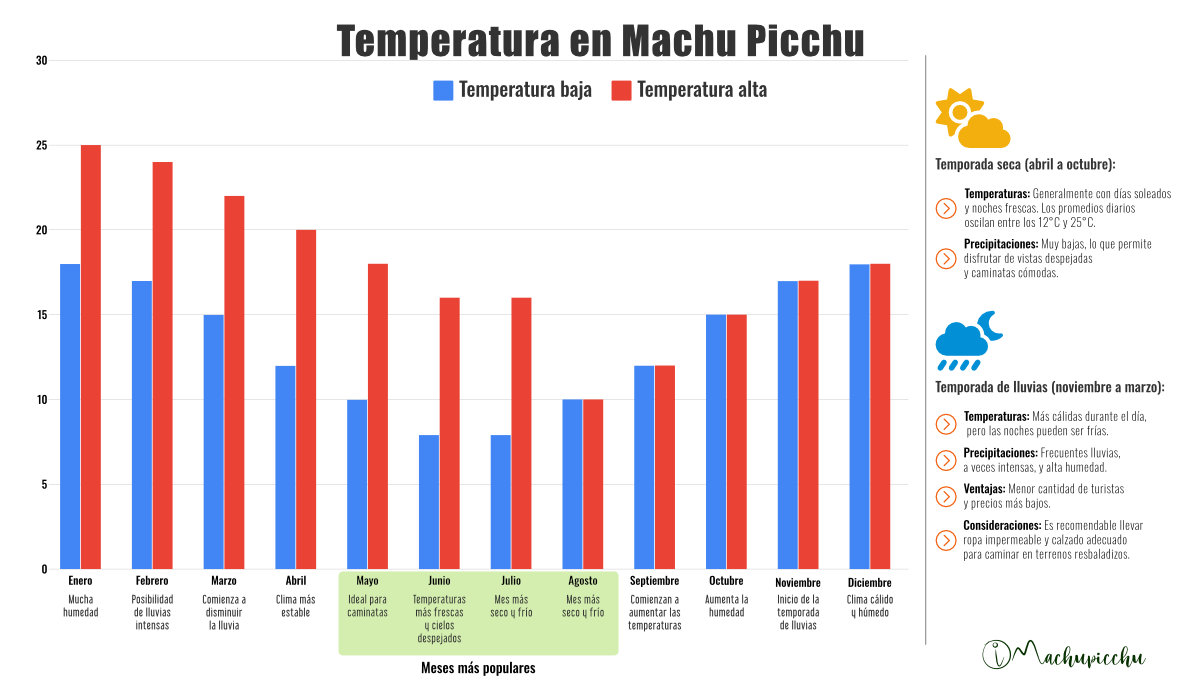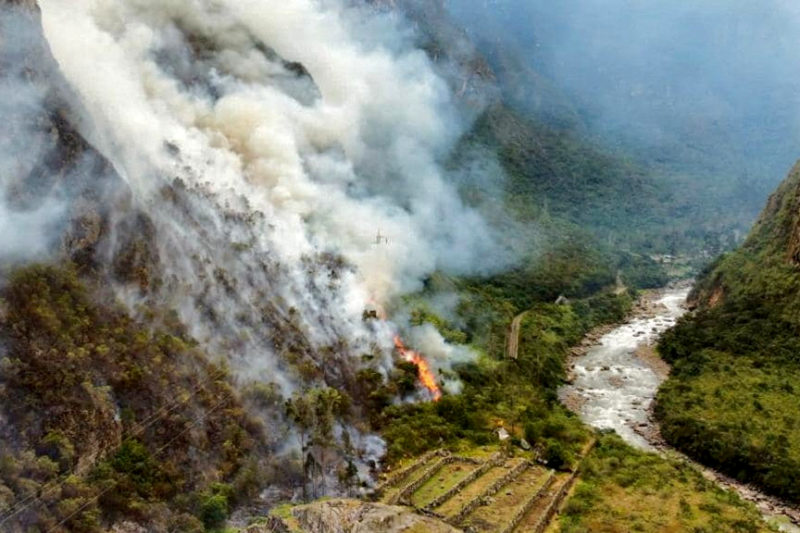Are there high temperatures in Machu Picchu?
Machu Picchu has a different climate than the city of Cusco, capital of the department of the same name in Peru. The fact is that Cusco, the capital of the Inca empire, is in the heart of the Andes Mountains, at an altitude of 3,399 meters above sea level. Meanwhile, Machu Picchu, the Inca citadel, is in the high jungle of the Andes Mountains, at an altitude of 2,430 meters above sea level. This lower altitude means that the Wonder of the World has a hot and humid tropical climate, unlike Cusco, a city with a temperate and cold climate, especially at night. Learn more about the high temperatures in Machu Picchu!
- The trip to Machu Picchu in the high jungle of the Andean Cordillera
- The weather in Machu Picchu: hot or cold?
- Temperature differences between Cusco and Machu Picchu
- Are the temperatures in Machu Picchu too high?
- Consequences of high temperatures at Machu Picchu
- Questions and answers about high temperatures on the trip to Machu Picchu
Can forest fires occur in Machu Picchu?
Yes, forest fires occur almost every year, not precisely at the archaeological site of Machu Picchu but in the surrounding Amazonian geographic area, especially in the months of higher temperatures (May, June, July and August). This is noted in reports of fires such as the one that happened in 2017: “Fire near Machu Picchu! The fire started last Thursday in the Aobamba ravine affecting flora and fauna in the buffer zone of the Inca city. The fire registers 10 kilometers from Machu Picchu and has affected about 70 hectares; 100 forest firefighters, assisted by police and workers of the Ministry of Culture of Cusco make strenuous efforts to prevent the fire from spreading.”
The trip to Machu Picchu in the high jungle of the Andean Cordillera
Machu Picchu is located on the eastern side of the Andes Mountains in Cusco, Peru. This high jungle region is characterized by green mountains and thick vegetation due to heavy rains.
The Inca city is located at 2,430 meters above sea level, in the valley of the Vilcanota River, also known as the Urubamba River. If you continue down the river route, you enter the Peruvian Amazon jungle. The Vilcanota River flows into the Madre de Dios River which, in turn, is a tributary of the Ucayali River and the Amazon River.
The trip to Machu Picchu starts from Cusco, the city that was the capital of the Inca empire and is located at 3,399 meters above sea level. That is, the trip leads from the high central mountains of the Andean Cordillera to the low mountains and Amazonian eastern side of the same, almost a thousand meters less altitude.
The trip departs from Cusco on a road trip to the town and train station of Ollantaytambo (2,792 masl). Then, a train ride of almost 2 hours to the town of Aguas Calientes (2,040 meters above sea level). On this trip, the visitor will appreciate how the Andean geography becomes little by little greener as one descends to the Amazonian zone of the Andes Mountains.
From Aguas Calientes you only take a bus that in about 30 minutes takes travelers to the entrance gate of Machu Picchu. In total, the trip takes almost 3 hours and 30 minutes. However, there are other routes such as the trip by the Hydroelectric route (8 hours) or the famous Inca Trail trekking route 4 days.
The weather in Machu Picchu: hot or cold?
The climate in Machu Picchu is humid, temperate and tropical with an average temperature of 18ºC. and 24ºC. as maximum. At night, the temperature drops to a minimum of 8ºC. at certain times of the year. Therefore, it is a hot temperate climate during the tourist visit. Likewise, rainfall, especially in months such as January, February and March, is copious with an average of 155 millimeters.
In Machu Picchu, as in Cusco, there are two seasons a year: the dry season (from May to October) and the rainy season (from November to April). The dry season is characterized by low rainfall, higher temperatures (with a maximum of 24ºC.) and colder nights (with a minimum of up to 8ºC). The rainy season, as its name indicates, is characterized by heavier rainfall (up to 155 mm), mild temperatures (maximum 22ºC.) and not so cold nights (14ºC. on average).
Temperature differences between Cusco and Machu Picchu
These are the temperature differences and the characteristics of the geographies in Cusco and Machu Picchu.
| Cusco and Machu Picchu | Climate in Cusco | Climate in Machu Picchu |
|---|---|---|
| Height | The city of Cusco is at 3,399 masl. | Machu Picchu is at 2,430 masl. |
| Geographical location | Cusco is located in the central part of the Andes Mountains. | Machu Picchu is on the eastern Amazonian side of the Andes Mountains. |
| Average temperature | 14ºC. | 18ºC. |
| Maximum temperature | 22ºC. | 24ºC. |
| Minimum temperature | 0ºC. | 8ºC. |
| What to wear? | Light clothing (such as polo shirt and pants) for daytime excursions but warm clothing (such as a jacket) for the evening. | Light clothing for daytime use (such as polo shirt and shorts) for daytime excursions but warm clothing (such as windbreaker) for the evening. |
| Recommendations | Due to the altitude of Cusco, it is recommended to adapt to the geography by drinking plenty of water and protecting yourself from the cold at night. | Machu Picchu is at an altitude where the symptoms of altitude sickness are not intense. It is recommended to protect yourself from mosquitoes and the intense sun. |
Are the temperatures in Machu Picchu too high?
- Machu Picchu has a hot temperate climate during the day and low temperatures at night. The average temperature during the tourist visit is 18ºC. The maximum daytime temperature is 24ºC. The minimum temperature at night is 8ºC.
- Although temperatures are not extremely high in Machu Picchu, it is recommended to protect yourself from the intense sun using a hat and sunscreen. It is also advisable to drink water during the tour of the archaeological site.
- To best adapt to the sunny climate of Machu Picchu you should bring light clothing such as hiking pants and a polo shirt. In a backpack you should also have a windbreaker and a rain poncho.
- Rainfall is more frequent in January, February and March. However, in the tropical and humid geography of Machu Picchu it can rain at any time of the day.
- Due to this tropical geography, there are many mosquitoes in Machu Picchu so it is recommended to bring insect repellent or simply wear clothes that protect the skin against the outside.
Consequences of high temperatures at Machu Picchu
- Possible fires caused by burning grasslands near Machu Picchu – It should be clarified that possible fires do not affect the Inca city of Machu Picchu, the Huayna Picchu mountain or the surrounding area, so people who have already planned their vacation to the wonder can come without any care.
- At certain times of the year, when there are grass fires, it is possible to perceive the smell of burning grass in the vicinity of the National Park, but there is no smoke or anything that affects the inhabitants of Aguas Calientes (Machu Picchu town) or visitors to the Inca city.
- For example, in 2007 there was a fire in the Aobamba area, located within the buffer zone of Machu Picchu National Park. The fire started at kilometer 122 of the Machu Picchu train tracks. The Inca city of Machu Picchu or any of the access roads were not affected.
- The police captured a farmer and his minor son, accused of having started a fire after a small burn on his property. These people were caught in flagrante delicto when the minor was burning garbage; the fire spread and became uncontrollable.
Questions and answers about high temperatures on the trip to Machu Picchu
1) Where is Machu Picchu located?
Machu Picchu is located on the eastern side of the Andes Mountains in Cusco, Peru. This high jungle region is characterized by green mountains and thick vegetation due to heavy rains. It is located at 2,430 meters above sea level.
2) How high is Cusco and how high is Machu Picchu?
The Inca city of Machu Picchu is located at 2,430 meters above sea level, in the valley of the Vilcanota River, also known as the Urubamba River. On the other hand, the city of Cusco, capital of the Inca empire, is located at 3,399 meters above sea level.
3)Are temperatures high in Machu Picchu?
The Inca city of Machu Picchu has Machu Picchu has a hot temperate climate during the day and low temperatures at night. The average temperature during the tourist visit is 18ºC. The maximum temperature during the day is 24ºC. The minimum temperature at night is 8ºC.
4) How is the climate in Machu Picchu compared to the temperature in Cusco?
In Machu Picchu, as in Cusco, there are two seasons a year: the dry season (from May to October) and the rainy season (from November to April). However, being at a higher altitude, Cusco has a cooler climate than Machu Picchu, where the days are warmer.
5) What are the hottest months in Machu Picchu?
The dry season months (May, June, July and August) are also the hottest months during the day while visiting the archaeological site of Machu Picchu.
6) What are the rainiest days during the trip to Machu Picchu?
The rainy season months (mainly January, February and March) are the rainiest, especially in the mornings when there are more clouds in the archaeological site of Machu Picchu.
7) Can fires affect Machu Picchu? What can they affect?
Yes, due to the dryness of the grasslands, the burning of farmers can cause fires. These cause a terrible impact on the flora and fauna of the place, affecting native species of reptiles, birds and rodents in the area. Let’s not forget that not only is it a historic sanctuary, but the national park is also considered part of the planet’s historic and natural heritage.
8) What to wear for the visit to Machu Picchu?
Due to the sunny days in Machu Picchu it is recommended to bring a polo shirt or blouse, comfortable pants for hiking, a hat and a windbreaker.
9) When is a bad time to visit Machu Picchu?
Machu Picchu can be visited every day of the year. A bad time to visit is perhaps the mornings of the rainy season days (January, February and March) when the rains can cover the beautiful landscape of the Inca city with clouds.
10) Is the heat in Machu Picchu dangerous?
No, the heat of Machu Picchu is safe for everyone if you use the recommended implements, such as a hat, sunscreen and drink water during the tour of the Inca city.
Advice from people who have been there
 By: Lucy B.
By: Lucy B.“Book train tickets as soon as possible“
“I was in Machu Picchu a few days ago, it was fabulous, but we had a problem, we already had the Machu Picchu tickets, but we could not book the train tickets in time (we forgot), even though it was not high season; we had to enter Machu Picchu by an alternate route through a village called Santa Maria. So if you are reading this; I would not risk it again. Buy train tickets in advance or book the trip to Machu Picchu with an agency, it costs a little more, but you will have the security of being able to enter Machu Picchu.“
By Ticket Machu Picchu – Last updated, November 11, 2024



